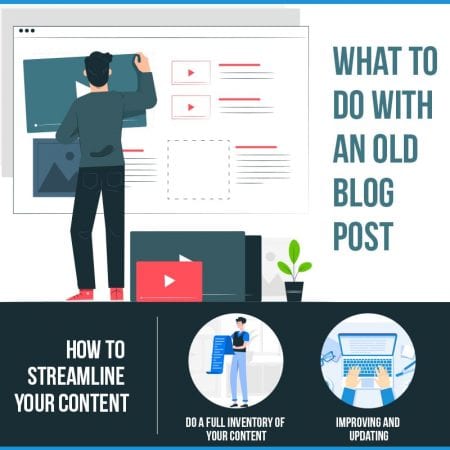 In the early 2000s, something new hit the internet: the corporate blog post. For a few years, it seemed like every company with a website was coming out with a blog. But with this influx of quantity, came a serious reduction in quality. Many of these blog posts focused solely on filling up a page with as many keywords as possible, with little regard for actually creating useful content. Given a bit of time, however, company blogs eventually began to focus less on bulk production and more on informative writing. But if you look closely at a branded blog, it can be easy to find traces of that old, low-quality content. So, what should you do about it?
In the early 2000s, something new hit the internet: the corporate blog post. For a few years, it seemed like every company with a website was coming out with a blog. But with this influx of quantity, came a serious reduction in quality. Many of these blog posts focused solely on filling up a page with as many keywords as possible, with little regard for actually creating useful content. Given a bit of time, however, company blogs eventually began to focus less on bulk production and more on informative writing. But if you look closely at a branded blog, it can be easy to find traces of that old, low-quality content. So, what should you do about it?
What’s the Big Deal?
So, your company blog has some old content. So what? First and foremost, a large backlog of content can lower the quality of your website. Old posts, both good and bad, are inevitably buried under new articles, and too many pages can greatly slow your crawl efficiency. If only one in every ten of your blog posts is worth reading, your crawl will be drastically slowed down. However, if you can raise that ratio, Google will take notice and be more likely to crawl through your pages and promote them to potential customers or clients. Ultimately, an old blog post update can end up increasing web traffic to your site.
Streamlining your content is also a great way to update your company image. A backlog of old, and lower quality, content can reduce the impact of your high-quality blog content. Reducing the number of posts can give you a clearer image, as well as providing your consumers with more attractive website design.
How to Streamline Your Content
So, what do you do after you’ve decided to do an old blog post update? The first step is to do a full inventory of your content. Once you’ve done that, you can decide what’s worth keeping. Some posts may be completely unsalvageable, and that’s okay. The ones you keep don’t have to be perfect, but they should still represent the image of your company you want to present to consumers. When you’re deciding whether or not to keep a post, ask yourself if it is beneficial to both the company and the consumer, if it is relevant to your current brand, and if it is done to a high-quality standard.
Next is step two: improving and updating. Old content, even if it’s good, can always benefit from an update or a rewrite. A good place to start is editing spelling and grammar. After that, make sure there isn’t any outdated information in the post, and make any stylistic tweaks as they are needed. It’s also a good idea to have your old content updated from a more technical standpoint. If you’re less familiar with this side of things, Local Tampa SEO Company can help.
Step three is expanding your old content to contain new, more relevant information. This leads to the final step of updating your blog: promoting your updated content. If you’ve gone through all the trouble of editing, updating, and expanding your content, it would be a waste to simply let it go unseen. Sharing your new content on other media sources is a great way to promote it and gain new consumers.
Final Steps
After revamping your blog, it’s important to watch for what changes have the most affect. Local Tampa SEO Company can help you monitor your analytics and use these insights to consistently keep your blog running smoothly and make proactive changes to continue improving your website.
